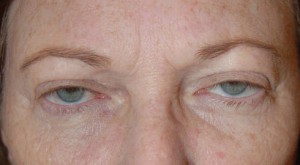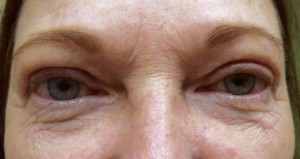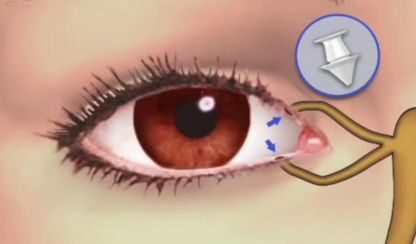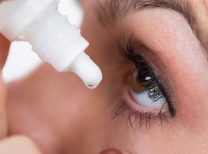The eyes play a vital role in human communication. We all want to look and feel our best, and our eyes go a long way in making a lasting impression. Ideally, we want to portray and emphasize our inner energy and vitality with a fresh, rested look. With time, however, our eyelids may appear tired or droopy. Ultraviolet exposure, the aging process and our own genetics play a role in bringing about these changes.
Our eyelid skin is among the most delicate on the body. As the tissues loosen over time, the skin becomes heavier and may even obscure the eyelashes. In the upper eyelids, affected individuals may notice eye strain or a headache as they subconsciously use their forehead muscles to lift this redundant tissue up and away from the field of view. Patients often complain of feeling and looking tired. An outpatient eyelid lift (blepharoplasty) removes this excess skin and restores a more youthful appearance.
When considering the different types of facial surgery, blepharoplasty is a procedure that brings lasting results. Upper eyelid blepharoplasty is often covered by your insurance. A short office evaluation and visual field test will determine if you are a candidate.
Living in the beautiful Coachella Valley also brings a keen awareness of the need for protection from strong ultraviolet rays. We must not forget the importance of protecting our eyelids. Eyelid lesions are often overlooked or easily missed, and may be benign or malignant. Signs of concern include loss of eyelashes, an irregular border, a non-healing area or a site of bleeding. Any suspicious lesion should be evaluated to ensure that potentially malignant lesions are caught in their earliest stage.
Even though the eyelids are an anatomically unique area, they are not immune to UV damage. Sunglasses that block UV-A and UV-B rays are extremely important. They will reduce exposure to the sun, and may also help to slow the progression of cataracts or macular degeneration. A large, wide brimmed hat is also helpful in protecting the eyes from rays that may elude the sunglasses. Lastly, some individuals choose to also apply a thin layer of aqueous based sunscreen on the eyelid skin. This added layer of protection can be incorporated into a person’s usual skin care regimen without much added time.
Another area that affects eyesight and quality of life is the lacrimal (tearing) system. Excessive tearing (epiphora) is a common complaint. Sufferers often learn to live with the symptoms and silently accept it. Epiphora interferes with many activities of daily living – reading, computer work, golf, tennis and interpersonal communication. The excessive tears cause blurry vision, and the skin may become irritated from frequent wiping.

BEFORE—This patient has excess skin of the upper lids as well as ptosis (drooping eyelids)
Over time, with excessive and vigorous drying of the eyes, the eyelids may become lax and lose their proper alignment. Without proper alignment, they function suboptimally. These mechanical changes may further exacerbate the epiphora. Even relatively mild eyelid positional changes can have a significant impact on symptoms.
There are many causes of excessive tearing, and there is no uniform diagnosis. A thorough examination by a lacrimal specialist is the first step in identifying the source and helping alleviate the symptoms. Many times, the lacrimal system must be evaluated for potential blockage with a short, relatively painless office procedure. First, a numbing drop is placed in the eyes. Next, the entrance to the tear drainage system (the punctum, which is akin to the drainage opening in a sink) is examined and dilated gently if necessary. Then, a small irrigating device is placed in the punctum and sterile saline solution introduced into the system. If the system is unobstructed, you will feel the liquid drain into your nose and the back of the throat. If there are any blockages, the procedure helps to determine the location of the blockage.

AFTER—Two months after an upper lid ptosis repair and blepharoplasty the patient looks and feels rejuvenated
The eyelids and the lacrimal system play key roles in maintaining a healthy ocular surface and optimal vision. Any change in their function can affect activities of daily living. Fortunately, there are many treatment options to relieve symptoms and improve your quality of life.
Dr. Hui is the founder of The Eyelid Institute in Palm Desert. She is an Oculoplastic surgeon with a special interest in cosmetic/reconstructive eyelid surgery and anti-aging treatments. An Oculoplastic surgeon is a physician with combined training in Ophthalmic Plastic and Reconstructive Surgery (Oculoplastics) and Ophthalmology who has unique abilities to perform a variety of delicate procedures around the eyes. Dr. Hui can be reached at 760.610.2677










































Comments (5)
I live up in the Seattle area and wonder if you would have a referral for someone up here with a similar specialty.
Dr. Hui has recommended Dr. Shu-Hong (Holly) Chang, M.D. in Seattle.
Please look in the directory for her contact information.
And thank you for reading Desert Health!
Yes we do. Pls call our office for the information. Thank you.
I am having tearing and dropping eyelids along with cataracts both eyes. I also worked as a Nuclear Medicine Tech for 43 years. Could working with radioactive materials have caused my problems?
I live in the Atlanta area. For years I have had tearing that is likely a result of several canthoplasty surgeries. I am having so much tearing with the slightest breeze. I am 70 years old now. Do you have a recommendation for a good surgeon in Atlanta? Thank you.